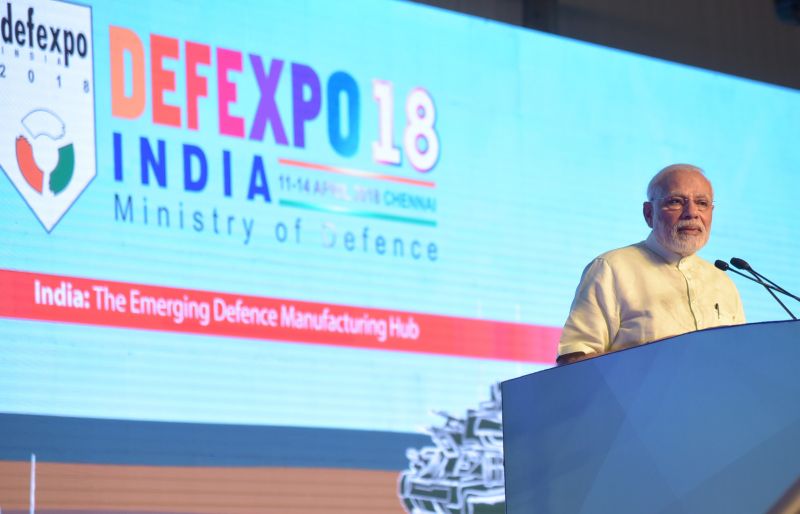New Government should compensate defence budget for GST loss
By Rohit Srivastava

Since 2014, ‘Make in India’ is the buzz word in defence. The Narendra Modi led NDA government, in its tenure, has made some very significant policy changes in the defence sector to give more avenues to private players, provide level playing field between the public and private sector. Some of these changes have created some new challenges for the government of one of them is a reduction in the capital budget due to the introduction of Goods and Services Tax (GST).
The Ministry of Defence (MoD) has made various policy initiatives to increase defence production in the country. The Defence Procurement Procedure (DPP)-2016, which came into effect from April 2016, emphasises on “institutionalising, streamlining and simplifying defence procurement procedure” to push ‘Make in India’ in defence, “by promoting indigenous design, development and manufacturing of defence equipment, platforms, systems and sub-systems.”
In the DPP-2016, MoD introduced a new procurement category with top priority Indian-IDDM (Indigenously Designed, Developed and Manufactured) and Strategic Partnership Model (inserted in 2017) for local production of submarines, aircraft, helicopters and tanks. Since then not much has happened.
As the government’s push for ‘Make in India’ in defence became institutionalised, simultaneously two things happened which has taken the wind out of sails. First is a minimal increase in the defence budget and second is the end of tax exemption on defence products.
Since Financial Year (FY) 2014-15 onwards, except for the 2016-17 which saw over 11 per cent increase, the annual increase in the defence budget has hovered around seven per cent. The 2016-17 increase was to pay for the 7th pay commission arrears. If one subtracts inflation from this modest increase we are left with just paltry around two per cent increase in the defence budget.
On the other hand, Government in 2015-16, with a view providing a level playing field to the domestic private sector vis-à-vis public sector defence enterprises, rolled back the excise duty and customs duty exemptions i.e countervailing duty (CVD) and special additional duty (SAD) available to the Ordnance Factory Board (OFB) and defence public sector.
Until 2014-15, only a small portion of the MoD funds was utilised for reimbursement of Tax.
Consequently, excise duty became chargeable and the impact of customs duty was at the rate of 18.5 per cent on the material cost component. Further, in the budget of FY 2016-17, the customs duty on direct imports by the MoD was also withdrawn, and basic customs duty (BCD), CVD and SAD were levied from April 1. The impact on the cost of defence product was in the range of 18.50 to 29.74 per cent.
In the next financial year, Government introduced Goods and Service Tax (GST) at the rate of 5, 18 and 28, which was later reduced to 5 and 18 per cent. Customs Duty of 5 to 10 per cent was levied on the defence imports.
The withdrawal of tax exemption has given the private sector a level playing field and introduction of import duty will shield the Indian industry against the cheap aggressive bid from global defence major. There has not been a consummate increase in defence capital budget to cater for the tax.
Giving industry’s perspective, Ashok Kanodia, MD, Precision Electronics, said, “GST at 18 per cent is a direct outflow for MoD. To this effect, their purchase power is reduced. Ministry of Finance should reimburse MoD the GST amount to bring about the purchase power parity. This is not an increase of MoD budget but a transfer of funds already collected. From one pocket to another.”
Adding further, he said, “They may argue that GST credit has been availed by the vendor but let them say so. This would mean that the principle agreement is in place. The question is now only the amount. 18 or 9 based on 50 per cent input cost.”
For the government, there is no loss but for the defence procurement or capital expenditure (CAPEX) budget, it is a loss. At a time when Indian forces need to replace its legacy equipment and the Indian private sector which needs the order to establish itself, this loss of 18 per cent from CapEx when the money is just enough to pay for committed liabilities, is unacceptable.
Giving armed force’s perspective, Lt. Gen. Subrata Saha (Retd) said, “Indian Army in its report to the Parliamentary Standing Committee in March 2018 had submitted, the challenges on account of having to factor in the taxes in an already constrained budget.”
Calling the last five years as the most transformative period in the Indian defence Sector, industry leader J. D. Patil, Whole -Time Director, L&T, said, “Unfortunately the policy reforms could not be matched by the speed of implementation and provision of budgetary support towards capital allocations. The stagnation in CapEx allocations over the past five years can be seen by the back of the envelope calculation of budget allocation net of Taxes.”
“The new government needs to take cognizance of the state of ageing inventory with the armed forces and make appropriate allocations towards military modernisation funds in the budget for FY20 and later years,” Patil added.
One cannot ask for the withdrawal of GST but the government will have to reimburse the GST amount to the capital budget. This is the only way out if the government wishes to modernise Indian forces with India made weapon systems.




